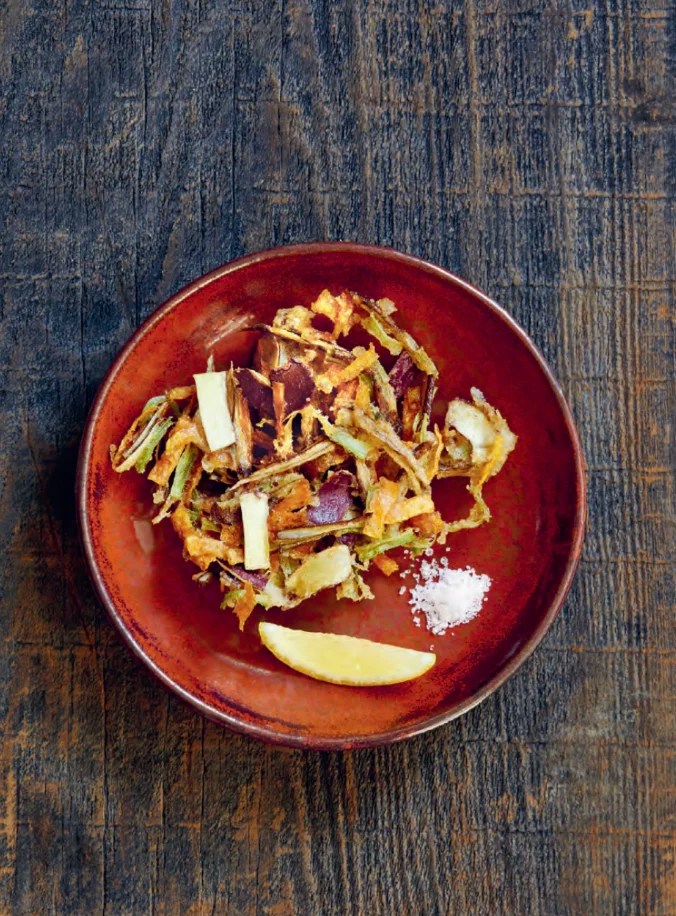In her latest cookbook, Japan: The Vegetarian Cookbook (a follow-up to her global bestseller, Japan: The Cookbook), which debuted in April 2023, Hachisu showcases over 250 Japanese vegetarian dishes, highlighting the flavors of the nation through a plant-forward lens. We recently caught up with Hachisu, who delved into some of the benefits of integrating more plants into our diet and what she’s learned about the Blue Zone, Okinawa, home to some of the longest-living people in the world.
Why lifestyle and cuisine are closely intertwined when it comes to longevity
According to Hachisu, Okinawa has been famously associated with the “Blue Zones,” aka five regions where folks live some of the healthiest lifestyles (and well into their 100s). This has drawn a lot of attention to the island for obvious reasons. And people all around the world are looking to replicate the practices of these communities. “There has been quite a lot of focus from the West on the Okinawan diet,” Hachisu says.
Although a healthy diet can be critical to well-being, Hachisu notes it isn’t the only factor likely leading the Okinawan longevity charge. Rather, it’s an amalgamation of several factors: lifestyle, geography, and access to certain foods. “The Western version of the Okinawan diet seems more focused on weight loss or incorporating components of the diet in order to promote good health and extend life span in their home countries,” shes says. “But Okinawans’ impressive longevity cannot be attributed solely to a specific diet. Historically, Okinawans existed in communities attuned to nature, in proximity to the sea, and isolated from the Japanese mainland,” she says. This has led Hachisu to take note of the close relationship between nature, food, and their nourishing benefits when combined.
What do Okinawans eat for longevity?
Being geographically isolated from the mainland has led Okinawans to rely primarily on the foods readily available in their region. “The traditional Okinawan diet consisted of plant-based ingredients such as soybeans and vegetables that are rich in antioxidant nutrients and dietary fiber—both of which are effective against diseases and infections, thus promoting increased lifespan,” Hachisu says.
What’s more, she says they also historically ate lots of carbs and low amounts of protein. “Overall, the diet in Okinawa was high in carbohydrates—mainly through sweet potatoes and other fibrous tubers, rather than grains such as rice—low in protein—little dairy, but a small amount of pork for enriching the island’s signature underpinning flavoring stock—and very low in fat,” Hachisu says.
But over the years, this has changed due to advancements in transportation. “Today, due to urbanization and influences from the American armed forces presence as well as imported foods from the mainland of Japan, the Okinawan diet has shifted significantly,” she says. “Carbohydrate consumption has dipped more than 25 percent, while protein and fat intake has increased about 10 percent each.”
Still, plants are integral to the Okinawan diet and overall Japanese cuisine, as reflected in Hachisu’s new book. “Green leafy vegetables and orange- and yellow-colored vegetables remain important elements in the daily foods of Okinawa. Also, foraged mountain herbs and plants such as mugwort continue to be valued and incorporated into the dishes—especially in the spring when they appear around the streams and in the fields,” she says. “Konbu and soy-based foods such as tofu and miso have also sustained a main place in the modern Okinawan diet.”
So what does this all mean for people living outside of Okinawa who want to absorb some of the traditional Okinawan lifestyle and diet into their own lives? Hachisu breaks it down into five main pillars:
- exercise in a natural environment
- spend time outside in fresh air
- eat less meat, fat, dairy, and rice
- eat sweet potatoes, carrots, daikon, bitter melon, cabbage, okra, kabocha, konbu, and soy-based foods such as tofu and miso
- eat mindfully until you are only 80 percent full
3 recipes featuring Okinawan-style ingredients
As a glimpse into her new book, Hachisu shared three recipes featuring Okinawan-style ingredients and their benefits.

Lemon-simmered sweet potato recipe
This recipe is the ideal way to enjoy cold sweet potatoes. Okinawa is one of Japan’s most important islands for artisanal sugar production, so the Okinawan diet eschews processed sugars. But here, the light lemony syrup is only slightly sweetened with organic sugar, and the dried gardenia fruit contributes color and healthy properties. Sweet potatoes have a lot of dietary fiber. When eaten in a cooled state, they have a component called resistant starch that is said to have additional benefits of aiding intestinal regulation and controlling sudden rises in blood sugar levels.
READ RELATED: Kombu: Edible Kelp for Digestion, Thyroid Function & More
Yields 4 servings
Ingredients
2 small sweet potatoes (5¼ oz/150 g each)
4 Tbsp freshly squeezed lemon juice
2 Tbsp organic granulated sugar
1 dried gardenia fruit pod (kuchinashi), optional
- Scrub the sweet potatoes, do not peel, and slice into rounds ½ inch (1 cm) thick. Place in a medium saucepan, add the lemon juice, sugar, and 1 ⅔ cups (13½ fl oz/ 400 ml) water. Break open the kuchinashi (if using) and drop in as well. Bring to a simmer over medium-high heat and cook until the flesh can be easily pierced with a bamboo skewer, 12–15 minutes. Remove the kuchinashi and let the sweet potatoes cool to room temperature in the cooking liquid. Refrigerate for two hours to chill.
- Serve as a sweetly tart side dish or small bite.

Root vegetable peel fritters
These fritters are a genius way to use those healthy root vegetable peels that were in direct contact with the mineral-filled earth where the root vegetables grew. Here the hard-to-find udo can be substituted with celery or omitted in favor of more sweet potato and carrot. The Okinawan diet does include fried foods, in moderation, as a way to introduce an element of richness to a meal, and these root vegetable peel fritters are perfectly aligned with that spirit.
Yields 4 servings
Ingredients
4 inches (10 cm) medium burdock (1 ¾ oz/50 g), scrubbed
2 handfuls non-juicy root vegetable peels (carrot, udo, sweet potato), removed with a vegetable peeler
5 Tbsp unbleached udon flour or pastry flour
2 Tbsp shiratamako
Neutral oil, such as canola (rapeseed), peanut, or safflower, for deep-frying
4 small wedges green yuzu or lemon, for serving
¼ Tsp flaky sea salt, for serving
- In a small bowl, whisk the udon flour and shiratamako together and sprinkle over the vegetables. Toss to distribute with a pair of cooking chopsticks. Sprinkle in a scant ½ cup (3½ fl oz/100 ml) cold water and toss gently to wet the flour.
- In a large high-sided sauté pan, heat 1¼ inches (3 cm) oil over medium heat until 340°F (170°C). To check the oil temperature, sprinkle a few pinches of the flour mixture into the oil; they should sink to the bottom of the pan, then immediately float back to the surface, and there will be a few bubbles.
- With a round serving spoon, scoop out 4 heaping spoonfuls of the ingredients and add them to the oil one at a time, slipping them into the oil at the edge of the pan. Fry for one minute, flip, then one more minute, before flipping and cooking until crispy and golden on both sides, 1½ minutes longer. Drain briefly on a rack set over a pan to catch the drips.
- Arrange the kakiage on saucers lined with a folded piece of tempura blotting paper. Serve hot with a yuzu or lemon wedge and a small mound of salt.

Sweet potato rice recipe
This recipe clearly contains rice, but it’s easy to adjust it to increase the sweet potato to rice ratio by doubling or tripling the amount of sweet potato called for in the original recipe. Doing so will increase the volume of the dish and thus increase the number of people it serves.
Yields 4 servings
Ingredients
1 ⅔ cups (5¼ oz/150 g) cubed (½-inch/1 cm) unpeeled sweet potato
2 ¼ cups (540 ml/1 lb/450 g) Japanese short-grain rice
½ teaspoon flaky sea salt
1 tablespoon black sesame seeds
- Wash, drain, and soak the rice according to the directions for Japanese rice. Stir in the rinsed sweet potato cubes and salt. Cook and rest according to the directions for Japanese rice. After resting, fold in the black sesame seeds, by sprinkling in evenly as you cut the rice with a rice paddle.
- Serve mounded in small bowls to accompany a couple vegetable side dishes.
Recipes courtesy of Japan: The Vegetarian Cookbook.
Our editors independently select these products. Making a purchase through our links may earn Well+Good a commission.
Source




